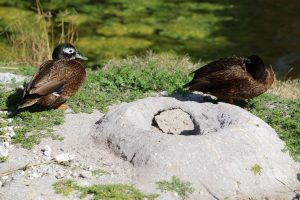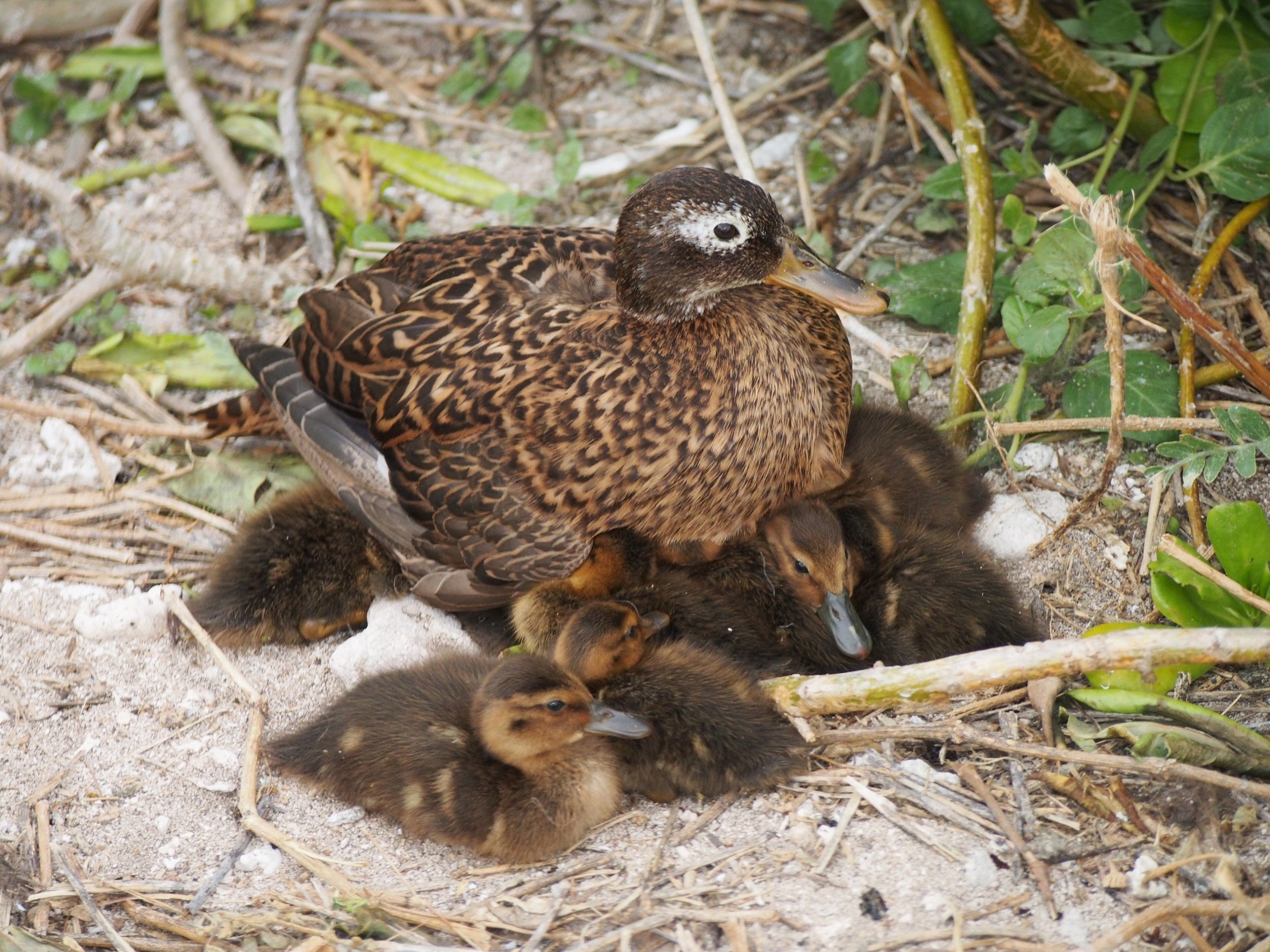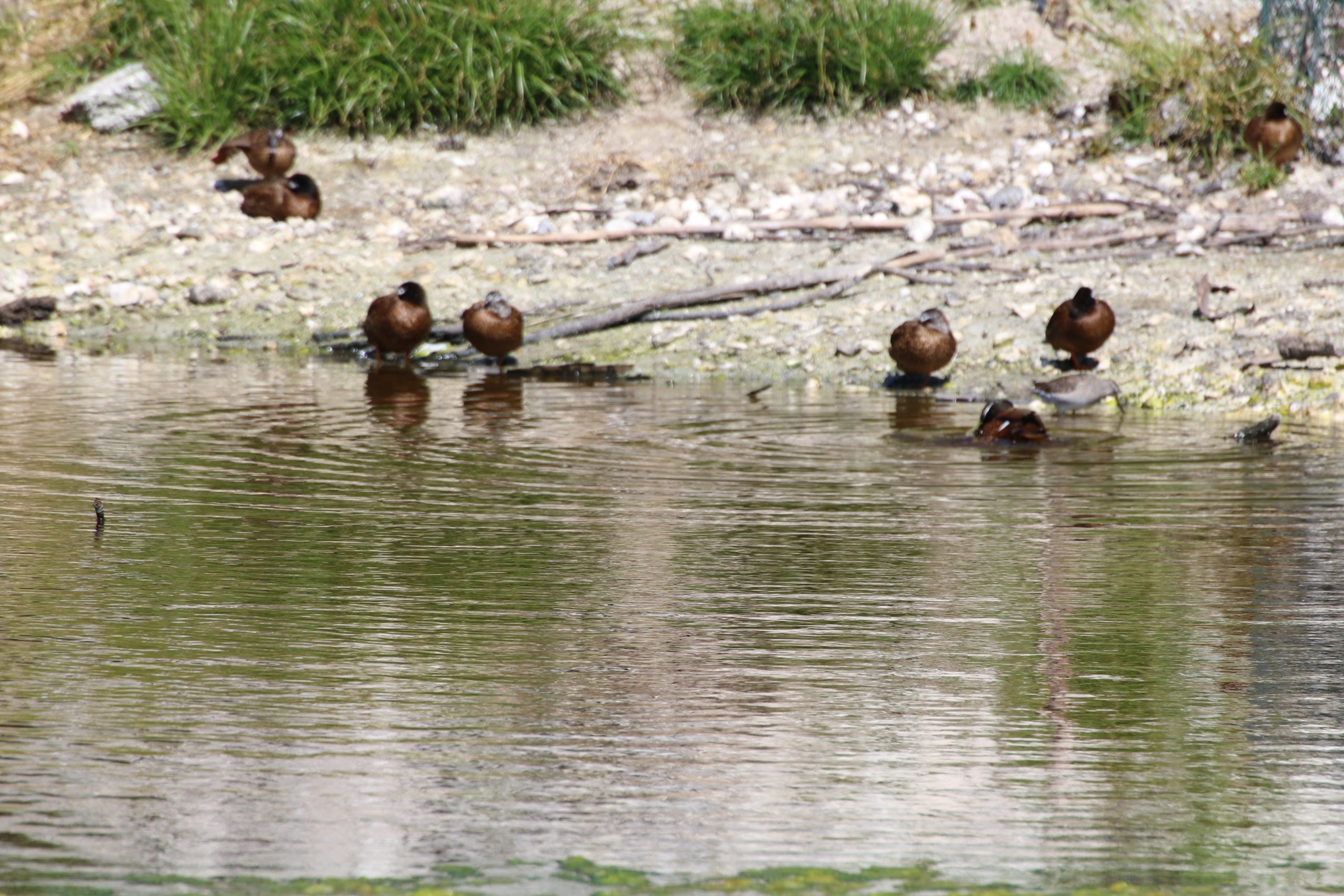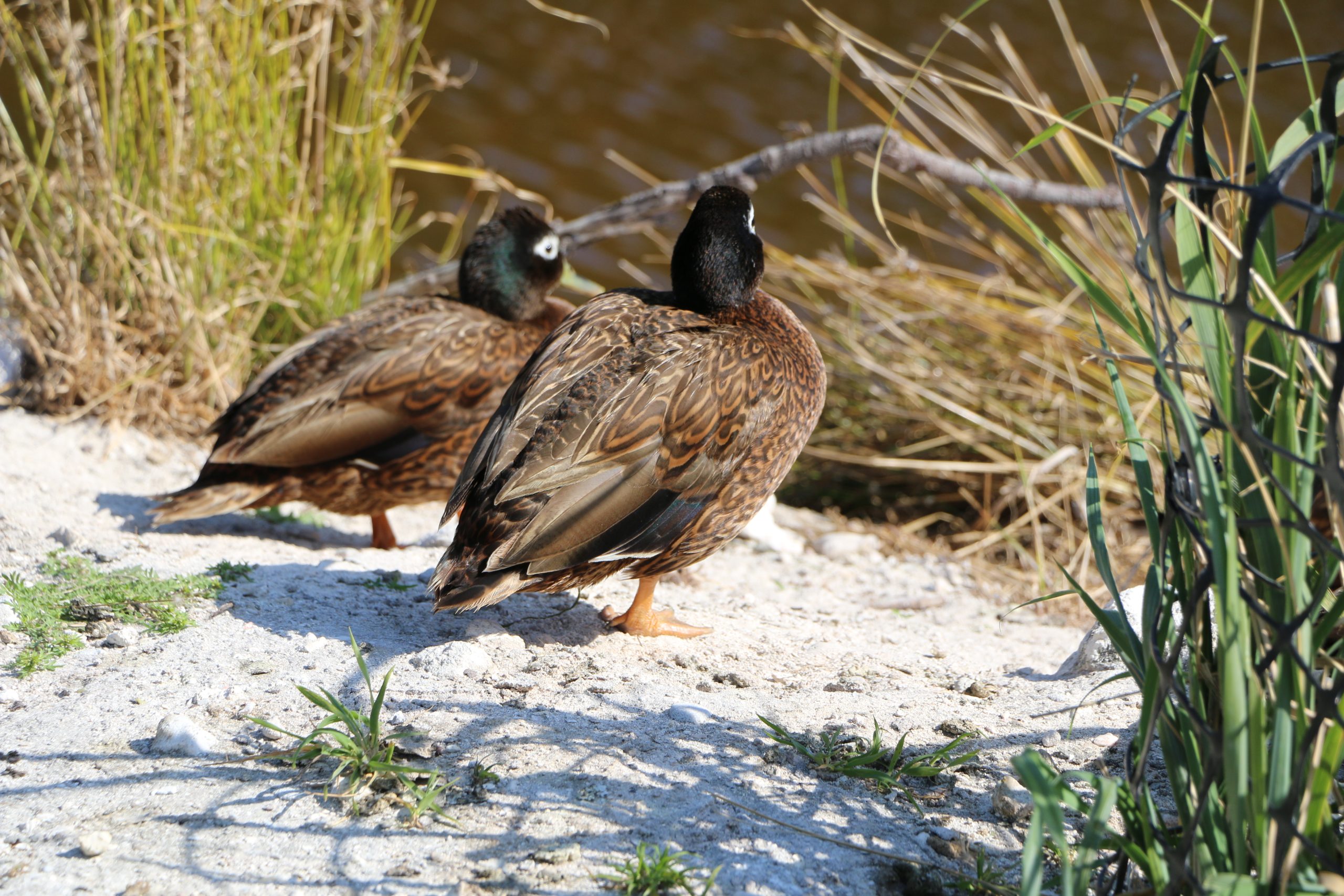Laysan Duck

Names
- ʻŌlelo Hawaiʻi: Koloa pōhaka
- Common: Laysan Duck
- Scientific: Anas laysanensis
Song
Conservation Status
- Federally Listed as Endangered
- State Listed as Endangered
- IUCN Red List Ranking – Critically Endangered
Species Information

Laysan ducks. PC: Daniel Dennison
The Laysan duck is a small dabbling duck (Family: Anatidae) endemic to Hawai‘i, and until recently was restricted to Laysan Island (370 hectares, or 911 acres) in the Northwestern Hawaiian Islands (NWHI). Even after recent successful translocation efforts to establish new populations on Midway and Kure Atolls, the species still has one of the smallest geographic ranges of any duck. Adults are dark brown overall with a prominent white eye-ring and varying amounts of white feathers on the head and neck; the sexes are similar. Unlike many other duck species, Laysan ducks have low fecundity and are nocturnal, very terrestrial, and highly sedentary; the species also is relatively long-lived. During the day, ducks take cover under vegetation such as bunchgrass or shrub. Individuals forage mainly at night around and in a large hypersaline lake, feeding primarily on the larvae and pupae of Dipteran brine flies and adult Dipteran brine flies, the larvae and pupae of a noctuid moth, and brine shrimp. Seeds, leaves, algae, and other invertebrates also are eaten. In the most common method of foraging, the Laysan duck runs through swarms of adult brine flies while moving its head back and forth, snapping up flies. Moth larvae and pupae are taken by “filter feeding” in sand under low vegetation. The species also dabbles along the lake shore. Long-term pair bonds are not formed, and males do not participate in brood-rearing. Nesting occurs between February and November, although most eggs are laid between April and August. Nests are well concealed and typically are placed at the base of dense vegetation, especially bunch grass. Nests are shallow scrapes lined with dead grass and some down. Typically three to five eggs are laid, and they hatch after 28 days. Ducklings are precocial (when hatched they have the ability to move and feed independently) and are not fed by the female. Because the species evolved with avian predators, when surprised, individuals tend to walk away rather than fly and freeze rather than flush.
Distribution
The Laysan duck currently occurs only on Laysan Island, Midway Atoll, and Kure Atoll in the NWHI; the population on Midway Atoll was a result of a successful translocation effort that occurred in 2004–2005. This success enabled 28 young adult birds to be relocated from Midway to Kure Atoll in 2013 which has greatly facilitated the reintroduction effort. Fossil and subfossil evidence indicates that Laysan ducks were widespread in the NWHI and Main Hawaiian Islands (MHI) prior to the arrival of Polynesians and occurred on the islands of Hawai‘i, Moloka‘i, O‘ahu, Maui, and Kaua‘i. Laysan ducks were extant on Lisianski as late as 1844.
Habitat
Two habitats are critical to the survival of Laysan duck: vegetated uplands and wetlands. Uplands supporting vegetation such as beach naupaka and bunch grass provide ducks with shelter and nesting habitat, and hypersaline lakes provide important foraging habitat. The importance of upland vegetation was demonstrated by the severe decline of ducks at the turn of the last century, when rabbits denuded Laysan, and by the species’ subsequent recovery after the rabbit population was eradicated in the 1920s and the vegetation recovered. Similarly, the number of ducks varies considerably depending on lake water levels; in 1987, there was a total breeding failure due to a drought and a lack of brine flies.
Threats
Historical threats included the introduction of rabbits, which subsequently denuded the island’s vegetation (see above), sport hunting, and guano mining. The species’ limited population size and geographic range exacerbates the risk of extinction from demographic and environmental stochasticity and catastrophes. These threats include:
- Nonnative species. Introduced plants have displaced native vegetation and degraded nesting habitat, and nonnative invertebrates may be altering habitat and affecting native species. Potential future reintroductions of the Laysan duck to the MHI are complicated by the presence of nonnative predators, such as cats, dogs, pigs, mongooses, and rats.
- Habitat degradation. Devegetation caused by introduced rabbits has resulted in filling of Laysan’s interior lake and freshwater seeps, which are an important habitat and food source for the duck.
- Disease. Avian botulism has occurred annually on Midway Atoll since 2008, resulting in high mortality and population declines.
- Contaminants. Oil spills, pesticides, and other types of contaminants washing ashore are potentially a serious risk to the species.
- Climate change. Sea level rise due to climate change may result in loss or degradation of nesting habitat, and increased frequency and severity of storms could reduce survival and nesting success.
- Catastrophes. The Laysan duck is vulnerable to environmental catastrophes, such as severe droughts, major storms, and tsunamis. For example, on Midway Atoll, some of the freshwater wetlands created for the ducks were damaged and inundated with saltwater by the Japan tsunami in 2011.
Photos
Additional Resources
For more information and references visit the DLNR State Wildlife Action Plan factsheets. DOFAWʻs species pages and State Wildlife Action Plan fact sheets are provided for general information and are not meant to be a citable, original source of data. If you are a student, researcher, or writer looking for a citable source, please explore the references below or find other original data sources, rather than citing these webpages. The references below were provided by the authors of the State Wildlife Action Plan fact sheets at the time of drafting:
- IUCN Red List of Threatened Species. 2015. Version 2014.3. www.iucnredlist.org. (Accessed May 2015).
- Moulton DW, Marshall AP. 1996. Laysan duck (Anas laysanensis). In The Birds of North America, No. 242 (Poole A, Gill F, editors). Philadelphia, (PA): The Academy of Natural Sciences; and Washington DC: The American Ornithologists’ Union.
- Reynolds MH. 2002. Habitat use and home range of the Laysan Teal on Laysan Island, Hawai’i. Waterbirds 27:183-192.
- U.S. Fish and Wildlife Service. 2009. Revised recovery plan for the Laysan Duck (Anas laysanensis). U.S. Fish and Wildlife Service, Portland, OR.
- U.S. Fish and Wildlife Service. 2012. Laysan duck (Anas laysanensis) 5-year review: short form summary. U.S. Fish and Wildlife Service, Honolulu, HI.




